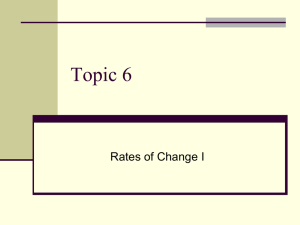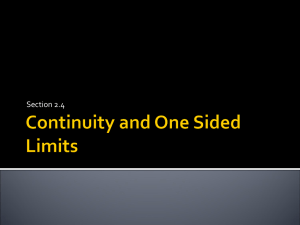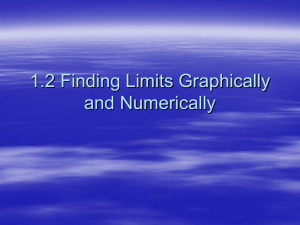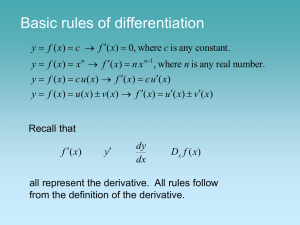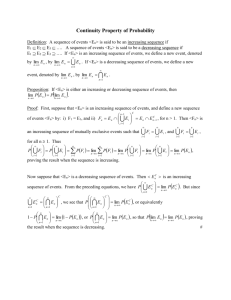Calculus Chapter 1 Review
advertisement
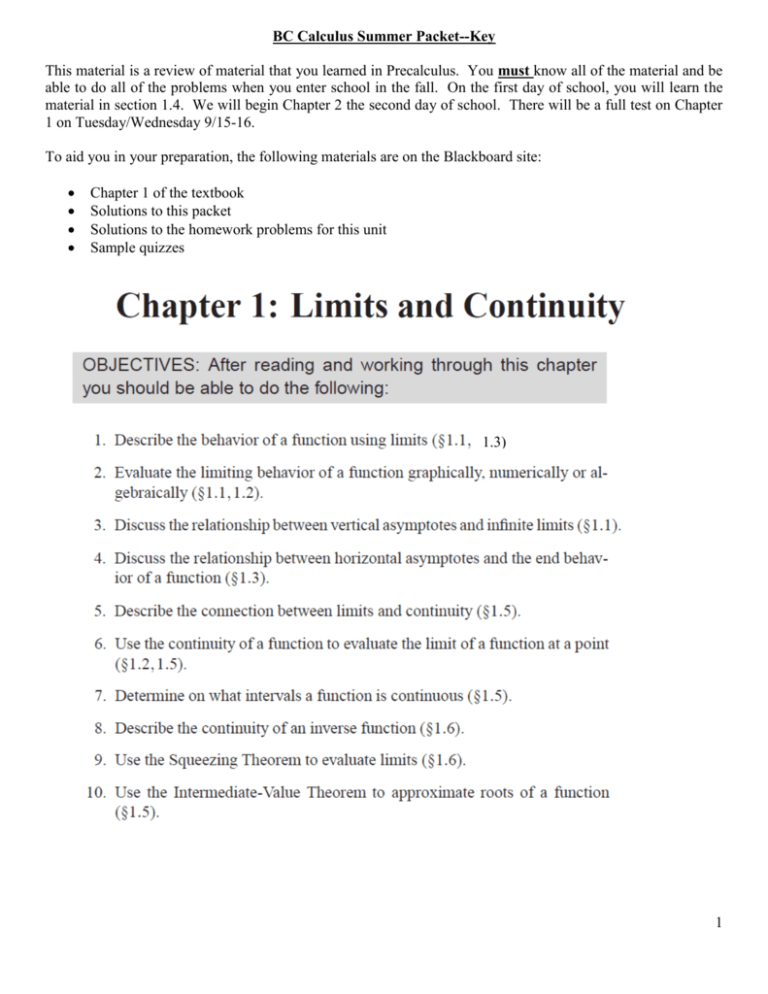
BC Calculus Summer Packet--Key This material is a review of material that you learned in Precalculus. You must know all of the material and be able to do all of the problems when you enter school in the fall. On the first day of school, you will learn the material in section 1.4. We will begin Chapter 2 the second day of school. There will be a full test on Chapter 1 on Tuesday/Wednesday 9/15-16. To aid you in your preparation, the following materials are on the Blackboard site: Chapter 1 of the textbook Solutions to this packet Solutions to the homework problems for this unit Sample quizzes 1.3) 1 1.1 Limits (An Intuitive Approach) If the values of f(x) can be made as close as we like to L by taking values of x sufficiently close to a (but not equal to a), then we write lim f x L x a which is read “the limit of f(x) as x approaches a is L” or “f(x) approaches L as x approaches a.” Examples: 1. Answer each using the graph below. a. lim f x 4 b. lim f x DNE x 5 c. 3 lim f x 0 x 2 d. x 0 x 4 2. Use a table to estimate lim x 0 x sin x x lim f x -0.1 0.99833 sin x =1 x -0.01 0.99998 1 cos x =0 x 0 x -0.1 -0.01 -0.05 -0.005 -0.001 1 0 DNE 0.001 1 0.01 0.99998 0.1 0.99833 -0.001 0.0005 0 DNE 0.001 0.0005 0.01 0.005 0.1 0.05 3. Use a table to find lim x 1 cos x x One-Sided Limits: If the values of f(x) can be made as close as we like to L by taking values of x sufficiently close to a (but greater than a), then we write lim f x L , or “the limit of f(x) as x approaches a from the right is L” x a And if the values of f(x) can be made as close as we like to L by taking values of x sufficiently close to a (but less than a), then we write lim f x L , or “the limit of f(x) as x approaches a from the left is L” x a If lim f x and x a lim f x both exist and are the same number L, then lim f x exists and equals L. x a x a If either one sided limit does not exist or, or they both exist but are different numbers, then lim f x does not exist (DNE). x a If lim f x L , then both one sided limits exist and are equal to L. x a 2 Examples: 4. Use the graph to answer each of the following: a. 1 d. lim f x x 2 0 c. lim f x 0 f. lim f x 1 i. lim f x x 2 lim f x 3 lim f x 1 x 2 g. b. e. x 2 x 0 h. x 0 5. (Hint: Graph) a. lim x 0 lim f x DNE lim f x 1 x 2 x 0 x -1 x 6. Find, lim f x 7 x 2 DNE lim f x x 2 where b. lim x 3 3x 1 f x 8 x2 3 x2 Since the left and right hand limit is 7 even though f(2) = 8 there is a hole but the limit does exist x2 x2 7. Determine if the statement is sometimes, always, or never true a. If lim f x does not exist, then lim f x does not exist. x 2 x 2 b. If lim f x does not exist, then lim f x does not exist. x 2 x 2 x3 -1 3 x Sometimes Always Infinite Limits: Sometimes lim f x does not exist because as x is assigned values that approach a the corresponding f(x) x a values grow larger without bound. In this case we say lim f x x a Remember that lim f x still means lim f x does not exist, but it fails to exist in this special way. x a x a lim f x means f(x) becomes smaller without bound as x approaches a. x a Examples: 8. Evaluate the limits given the graph of f(x): a. x 2 b. f. ∞ ∞ ∞ h. lim f x -∞ ∞ i. x 0 x 0 x 2 d. lim f x x 3 e. lim f x DNE x 0 lim f x x 3 DNE g. lim f x lim f x lim f x lim f x x 3 x 2 c. ½ lim f x 0 False If lim f x and x a lim g x then xa lim f x g x 0 xa 1 1 g ( x) 4 2 x x lim f ( x) g ( x) f ( x) x 0 3 Homework Problems (from textbook): p. 77: 3, 9, 23, 31 23. Sketch a possible graph for the function f with the following properties: i) the domain of f is ,0 ii) f (2) f (0) 1 iii) lim f ( x) x 2 Homework Answers are in a separate document. 4 1.2 Computing Limits Look at pgs. 80-81, Theorems 1.2.1 and 1.2.2, for basic limits and limit laws Note that the limit laws (limit of a sum, difference, product, quotient of two functions) only apply if the limits of both of the functions exist at the specified point. Computing Limits Algebraically --– substitution, factoring, rationalizing, simplifying complex fractions. Examples: Evaluate each of the following. 1. 2 lim 4 x 10x 3 x 6 2. x2 6x 5 ( x 5)( x 1) lim lim 4 x 1 x 1 x 1 x1 4(36) – 10(6) + 3 = 87 4 x 44 3 20 44 3 64 4 3. lim x 5 6 x 29 30 29 3 x2 x3 f x 6 x 4 x 3 4. lim f x where x 3 lim f ( x) lim f ( x) x 3 x 3 14 9 lim f ( x) DNE x 3 5a. f (2) g (2) 5b. 3+3=6 lim f g x x 2 lim f ( x) lim g ( x) 1 3 4 x 2 6. 8. x 2 1 x 1 x2 (1 x)(1 x) lim x lim lim 11 2 x 0 1 x 0 1 x x 0 (1 x ) 1 x lim x2 7. 2 x 2 2 x 2 x 2 x 2 2 x2 1 1 lim lim x 0 x 2 x 2 x 0 2 2 2 x 2 lim x 0 x x 2= - ∞ 5 Practice: Given the functions f(x) and g(x) below, evaluate the limits or explain why they don’t exist: 9. lim f x g x x 0 9. lim f ( x) g ( x) 1 2 3 x0 12. lim f x g x x 3 12. lim f ( x) g ( x) 1 3 4 x 3 lim f ( x) g ( x) 2 1 1 x 3 limit dne 15. lim f g x x 3 10. lim f x g x x 0 10. lim f ( x) g ( x) 1 2 3 x0 13. lim f x g x x 0 13. lim f ( x) g ( x) 1(2) 2 x 0 lim f ( x) g ( x) 1(2) 2 x 0 lim f ( x) g ( x) 2 x 0 16. look at lim g ( x) 3 look at lim g ( x) 2 lim f ( x) 2 (look from above/right) x 3 lim f ( g ( x)) x 3 look at lim g ( x) 1 x 3 lim f ( x) 2 (look from below/left) x 1 lim f ( g ( x)) 2 x 3 x 0 from #9 and 10, the limit is 3 14. lim f x g x x 3 14. lim f ( x) g ( x) 1(3) 3 x 3 lim f ( x) g ( x) 2(1) 2 x 3 limit dne x 0 16. lim f ( g ( x)) x 3 lim f x g x lim f g x 15. lim f ( g ( x)) x 3 11. x 0 x 0 lim f ( x) 2 (look from above/right) x 2 lim f ( g ( x)) x 0 look at lim g ( x) 2 x 0 lim f ( x) 2 (look from below/left) x 2 lim f ( g ( x)) 2 x 0 6 Homework Problems (from textbook): p. 87: 2, 5, 8, 15, 29, 37, 40, 41, 43 5) Evaluate lim x 3 29) Evaluate x2 2 x x 1 lim x 9 x 9 x 3 x t3 8 15) Evaluate lim t 2 t 2 x 3 x 3 x4 2 37) Evaluate lim by rationalizing the numerator. x 0 x 8) Evaluate lim Homework Answers are in a separate document. 7 1.3 Limits at Infinity; End Behavior of a Function Evaluate: 3x 7 4 x5 3x 1 3 2. lim x 2 x7 4 2 2 1. lim 5 x3 7 x2 1 0 x 3 x 2 x 3 x3 6x 1 x 2 x 2 5 x 3. lim cos x 5. lim x x DNE 1 4. lim tan x x 2 x DNE oscilates 1 6. lim 1 = e x x f x , L A horizontal asymptote for a function f is a line y = L such that , lim x both. f x L or xlim A function may have at most 2 horizontal asymptotes. Limits involving Radicals: Recall that x 2 x x . We can use this fact to transform limits involving radicals and use the same principals as those with rational functions. Examples: 7. xlim x x2 1 9. Given f ( x ) =1 8. lim x 2x 5 x2 4 =-2 2x 5 give the horizontal asymptote(s). y = ± 2 x2 4 Remember you may cross a horizontal asymptote 8 Another type of problem that doesn’t look the same but can be solved in a similar manner is one like lim 9 x2 x 3x x It looks like this limit might be zero, but it is important to remember that the rules of algebra do not apply to the concepts of infinity and negative infinity. In other words, does not necessarily equal zero. Instead, we will approach this problem by multiplying by the conjugate Natural base e defined by a limit: nt r You have seen in precalc that the limit of the compound interest formula A P 1 leads to the continuous n rt compounding formula A Pe . You can easily see from a graph or table that generalizing that result leads to x 1 1 the definition: lim 1 lim 1 x x e x x 0 x Examples: 3x x 2 11. lim 1 e 2 x x 1 10. lim 1 e3 x x Homework Problems (from textbook): p. 97: 6gh, 17, 19, 21, 27, 31, 33, 40 6) Given that lim f ( x) 7 and lim g ( x) 6, find each of the following limits or explain why the limit does x x not exist. g ( x) lim f ( x) x x2 17) Evaluate lim 2 x x 2 x 1 6 t3 21) Evaluate lim 3 t 7t 3 (g) (h) x 31) Evaluate 40) Evaluate lim x x2 3 x lim 1 1 x x xf ( x) x (2 x 3) g ( x ) lim 19) Evaluate 27) Evaluate 33) Evaluate 7 6 x5 x x 3 2 y lim y 7 6 y2 lim 1 ex x 1 e x lim x Homework Answers are in a separate document. 9 1.5 Continuity (At a point): A function f is said to be continuous at x = c provided the following conditions are satisfied: 1. lim f x exists x c 2. f(c) exists (c is in the domain of f) 3. lim f x f c x c Examples: 1. Is 2. Is 3. Is f ( x) x continuous at x = 0? NO Jump Discontinuity f(0) DNE x x2 1 f ( x) x 1 x f ( x) x x continuous at x = 1? NO x0 x0 x2 4 4. Is f ( x) x 2 4 continuous at x = 0? x2 x2 NO Vertical Asymptote f(1) DNE f(0) exists but still disc continuous at x = 2? YES point disc filled in 1 x 1 x x 1 f ( x) 1 x 1 5. Is continuous at x = -1? 2 x 1 x YES At x = 1? NO If one or more of these conditions fail to hold, then we will say that the function has a discontinuity at x=c. There are three types of discontinuities that we will recognize: removeable discontinuity (hole), nonremoveable discontinuity, jump discontinuity, infinite discontinuity (vertical asymptote). Continuity on an interval: We say f is continuous on an open interval if it is continuous at each point on that interval. We say f is continuous on the closed interval [a, b] if it is continuous on (a, b), right continuous at a, and left continuous at b. Example 6: a. f ( x) x is continuous on (1, 2); YES b. Where is f ( x ) discontinuous? Every Integer c. g ( x ) x 1 is continuous on [1, 2]. YES 10 Example 7: a) At which points is the graph discontinuous? X= -2, 0, 2 b) On what intervals is the graph continuous? (, 2) (2, 0) (0, 2) (2, ) If f and g are continuous at a, then so are: kf , f g , f g , fg, f g 0, f n , and n f if n is even, f (c) 0 g Theorem: A polynomial function is continuous at every real number a. A rational function is continuous at every real number in its domain, i.e., except where its denominator is zero. The absolute value function is continuous at every real number a. If n is odd, the nth root function is continuous at every real number a, if n is even, it is continuous at every positive real number a. (p127) Example 8: Is f x x 2 6 x continuous 9 for all real numbers? YES Radicand is always + Intermediate Value Theorem (IVT): If f is continuous on [a, b] and if k is a number between f(a) and f(b), then there exists at least one number x between a and b such that f(x) = k. Example 9: Show that f(x) = x3 + 2x - 1 has a zero on the interval [0, 1]. f(x) is a polynomial so continuous everywhere f(0) = -1 f(1) = 2 -1 ≤ 0 ≤ 2 there is an x value such that 0 x 1 & f ( x) 0 Example 10: Given h(r) is a continuous function, explain why there must be a value r for 1< r <3 such that h(r) = -5 given that h(1)=3 and h(3) = -7 Since h(r) is cont and -7 ≤ -5 ≤ 3 there is an x value such that 1 x 3 where h(r ) - 5 Utilizing important definitions in an explanation of an AP free response problem is an important skill. Consider the following part of one free response problem. (2003AB4) Let f be the function defined by x 1 for 0 x 3 f ( x) 5 x for 3 x 5 Use the definition of continuity to prove that f continuous at x 3 ? 11 You must use the three part definition: 1. Show that f ( x) exists. f (3) 3 1 2 2. Show that lim f ( x ) exists. x c lim f ( x) lim x 1 2 x 3 x 3 lim f ( x) lim (5 x) 2 x 3 x 3 Because the left and right hand limits exist and are the same value, lim f ( x ) exists. x 3 3. Show that the value and the limit are the same and draw a conclusion. Because f (3) 2 and lim f ( x) 2 , f ( x ) is continuous at x = 3. x 3 Practice AP Multiple Choice 1. (1985AB29) Which of the following functions are continuous for all real numbers x? I. (A) yx 2 3 II. y ex None (B) I only III. (C) y tan x II only (D) I and II (E) I and III x2 4 when x 2 , 2. (1993AB5) If the function f is continuous for all real numbers and if f (x) x 2 then f (2) (A) 3. –4 (B) –2 (C) x 0 f (x) 1 (1998AB26) –1 (D) 0 (E) 2 1 2 k 2 The function f is continuous on the closed interval 0,2 and has values that are given in the table above. The 1 equation f (x) must have at least two solutions in the interval 0,2 if k 2 1 (A) (B) (C) 1 (D) 2 (E) 3 0 2 sin x 2 x 4. (1988BC5) Let f be the function defined by f (x) 2 x x 3 For what values of x is f NOT continuous? (A) 0 only (B) 1 only (C) 2 only if x 0 if 0 x 1 if 1 x 2 if x 2 (D) 0 and 2 only (E) 0, 1, and 2 12 Homework Problems (from textbook): p. 118: 17, 31, 45, 47 17) Find the values of x, if any, at which the function f ( x) 3 x 1 is not continuous. x x2 1 31) Find the values of the constants k and m, if possible, that will make the function f continuous everywhere. x2 5 x2 f ( x) m( x 1) k 1 x 2 2 x3 x 7 x 1 45) Give an example of a function f that is defined on a closed interval, and whose values at the endpoints have opposite signs, but for which the equation f ( x) 0 has no solution in the interval. 47) Show that the equation x3 x 2 2 x 1 has at least one solution in the interval [-1, 1]. Homework Answers are in a separate document. 1.6 Continuity of Trig, Exponential, and Inverse Functions The Squeeze Theorem: Let f, g, and h be functions satisfying g x f x h x for all x in some open interval containing the number c , with the possible exception that the inequalities need not hold at c. If g and h have the same limit as f approaches c, then f also has this limit as x approaches c. a. lim 0 sin ____ b. lim 0 1 cos 0 See tables on p 2 in Note Packet to determine these limits tabularly. You must know these limits. The Squeeze Theorem allows us to find limits of strange functions and to prove some limits analytically. Prove analytically that lim 0 sin 1 Go to https://www.youtube.com/watch?v=AZ2iWzE3Ykw to watch the proof of this statement. Examples using the above result using (a) above. We can use our basic limits and algebraic manipulation to find the following limits. 13 sin 5 x 1 x 0 5x sin 1 0 7 7 1. lim 2. 2. lim sin 4 x 4 x 0 7x 7 sin 3 x 3 x 0 x 4. lim lim sin 6 2 0 3 sin x 1 1 x 1 x 1 5. lim 6. lim Practice AP Multiple Choice Problems 7. (1997AB15) The graph of the function f is shown in the figure above. Which of the following statements about f is true? (A) (D) lim f (x) lim f (x) x a x b lim f (x) 1 (B) lim f (x) 2 x a x b x a 2 8. (1993AB2) If f (x) 2x 1, then lim x 0 (B) 1 lim f (x) 2 (E) lim f (x) does not exist x b (A) 0 (C) (C) 2 f (x) f (0) is x2 (D) 4 (E) nonexistent 14 x is x1 ln x 9. (1997AB21) lim (A) 0 (B) 1 e (C) ln x for 10. (1998AB12) If f (x) 2 x ln x for ln 2 (A) ln 8 (B) (C) 1 (D) e (E) nonexistent 0 x 2 then lim f (x) is x 2 2 x 4 ln16 (D) x 2 a2 4 4 is x a x a 1 (C) (D) 0 6a 2 4 (E) nonexistent 11. (1998AB83) If a 0, then lim (A) 1 a2 (B) 1 2a 2 (E) nonexistent Homework Problems (from textbook): p. 126: 23, 27, 32, 61 23) Evaluate lim sin 3 sin(h) 32) Evaluate lim h 0 1 cos( h) 61) Use the Squeeze Theorem to show that 50 0 27) Evaluate tan 7 x x 0 sin 3 x lim 0 , x and illustrate the principle involved by using a graphing utility to graph the equations y x , y x , and lim x cos x 0 y x cos(50 / x) on the same screen in the window [-1, 1] x [-1, 1]. Include a sketch below. Homework Answers are in a separate document. 15 Calculus: Exploring Limits and Continuity Worksheet (adapted from Instructors Guide that accompanies Stewart’s Calculus) 1. Given the functions f and g (defined graphically below) and h and j (defined algebraically), compute each of the following limits or state why they don't exist. Hint: for some of these you might need to look at left and right hand limits. x2 4 x2 1 if x 2 j ( x) 0 if x 2 1 if x 2 h( x ) f g 1 1 2 2 a. lim h( x) = 4 x2 b. 2 lim g ( x ) = 0 x2 c. lim[ g ( x ) h( x )] x2 DNE d. lim[ f ( x) g ( x)] = 0 x2 e. lim[ g ( x) j ( x)] x 2 (examine the right and left hand limits—both are 0) DNE (from the left, we get 1(1)=1, from the right we get 0(-1) = 0) f ( x) g ( x) h( x) j ( x)] = 6 f. lim[ x 2 2 x 2 2. Consider the function f ( x) x 2 if x 1 if x 1 a. Sketch the graph on the axes provided. Be sure to indicate holes properly. b. Let L lim f ( x). Find x 0 c. OMIT Find a number – 0| < 0.01 | x2| < 0.005 |2x2 x2 L. 0 0 so that if 0 x , then f ( x) L 0.01 < .005 x < 0.071 d. Show analytically that f does not have a limit at -1. lim ( x 2) 1 x 1 lim (2 x 2 ) 2 Limits are not equal;therefore,lim DNE x 1 16 10 x if x 1 2 3. Let f ( x) x if 1 x 2 4 if x 2 x a. Sketch the graph on the axes provided. Be sure to indicate holes properly. b. Evaluate each limit, if it exists. (i) lim f ( x) 3 (ii) lim f ( x) 1 (iii) lim f ( x) dne (iv) lim f ( x ) 4 (v) lim f ( x ) 2 (vi) lim f ( x ) x 1 x 1 x2 x 1 x2 x2 dne c. Answer each of the following questions with respect continuity of the function. to the (i) Is f(x) continuous on the interval (0, 1)? YES (ii) Is f(x) continuous on the interval [0 1]? YES (iii) Is f(x) continuous on the interval (1, 2)? YES (iv) Is f(x) continuous on the interval [1, 2]? NO (v) Is f(x) continuous on the interval (2, 4]? YES (v) Is f(x) continuous on the interval (2, )? YES (vi) Where is f(x) discontinuous? 1, 2 17 Calculus Chapter 1 Review Non-Calculator Multiple Choice 1. lim x 0 sin 2 x x A. 0 B. 1 2. The graph of y C. 1 2 D. 2 E. does not exist 2 x2 2 x 3 has 4 x2 4 x 1 but no vertical asymptotes 2 B. no horizontal asymptotes but two vertical asymptotes, at x = 0 and x = 1 1 C. a horizontal asymptote at y and two vertical asymptotes, at x = 0 and x = 1 2 D. a horizontal asymptote at x = 2 but no vertical asymptotes 1 E. a horizontal asymptote at y and two vertical asymptotes at x = 1 and x = -1 2 8 x 56 3. Find lim x 7 7x A. a horizontal asymptote at y A. 8 4. Find lim x2 B. –1 C. 1 D. –8 E. does not exist B. - C. 0 D. 1 4 E. does not exist 1 ( x 2) 2 A. 5. Find the value of the limit lim x2 A. 8 B. 4 x3 8 x2 C. 2 6. At what value of x does the function f ( x) A. –3 B. 3 C. 2 D. 12 E. 6 ( x 1) 2 have a removable discontinuity? x2 1 D. –1 E. 1 18 Calculator Multiple Choice 7. Suppose g is a function defined on the interval [0,5] such that lim g ( x) 1, find lim[ g ( x)]3 x 2 A. 8 1 B. 8 C. –1 1 D. 3 x 2 E. does not exist 8. For the function f ( x) whose graph is shown at the right, which statement is false? A. lim f ( x) 1 x 1 B. lim f ( x) 2 x2 C. lim f ( x) lim f ( x) x 0 x 0 D. lim f ( x) 2 x 1 E. lim f ( x) 2 x 1 Free Response (1976 AB 2) Given the two function f and h such that f ( x) x3 3x 2 4 x 12 and f ( x) for x3 h( x ) x 3 p for x3 a. Find all zeros of the function f . b. Find the value of p so that the function h is continuous at x 3 . Justify your answer. c. Using the value of p found in part (b), determine whether h is an even function. Justify your answer. Answers 1. D 2. C 3. A 4. A 5. D 6. D 7. C 8. D 1976 AB 2 a. 2, -2, and 3 b. 5 (justify by showing that limit exists at 3 from both sides, the value exists, and they are the same) c. h(-x) = (-x)2 – 4 = x2 – 4 = h(x) so it is even 19



